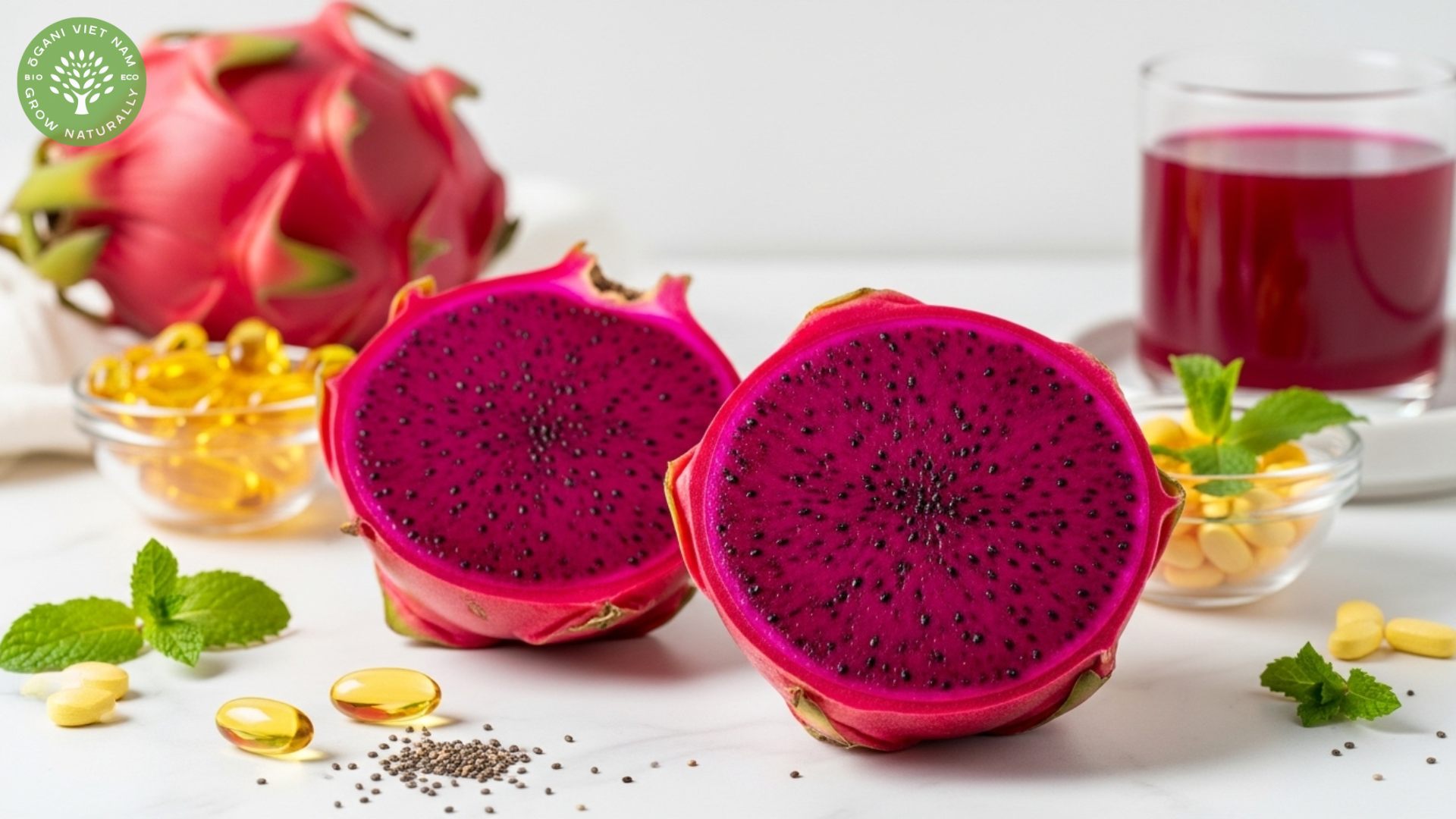Red dragon fruit nutrients are what we at Ogani VN are thrilled to explore with you in this comprehensive guide. This vibrant tropical fruit delivers an impressive nutritional profile, packed with essential vitamins, minerals, fiber, and powerful antioxidants like betalains that create its stunning crimson color.
Comprehensive breakdown of red dragon fruit nutrients
When we analyze the nutritional profile of red dragon fruit (also known as red pitaya), we’re consistently impressed by how much goodness nature has packed into this exotic fruit. Let’s dive into what makes this superfruit so special from a nutritional standpoint.
Macronutrients per 100g serving
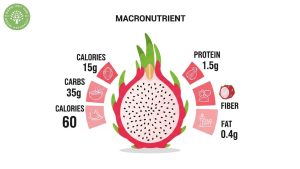
A standard 100-gram serving of fresh red dragon fruit provides approximately 50-60 calories, making it an excellent choice for health-conscious individuals. The macronutrient breakdown includes:
The carbohydrate content sits around 11-15 grams, primarily from natural fruit sugars that provide quick energy without causing dramatic blood sugar spikes. What’s particularly noteworthy is the fiber content – with 3 grams per 100g serving, red dragon fruit delivers about 12% of your daily fiber needs. The protein content is modest at 1.1-1.5 grams, while fat content remains minimal at just 0.4 grams.
Essential vitamins and minerals
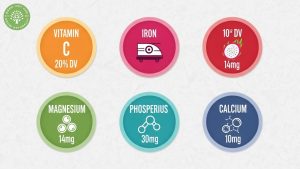
Red dragon fruit truly shines when it comes to micronutrients. The vitamin C content is remarkable – a single serving provides about 20% of your daily requirement, supporting immune function and collagen production. We’ve found that the magnesium content (10-14mg per serving) rivals that of leafy greens, contributing to muscle function and energy metabolism.
Iron content in red dragon fruit deserves special mention. With 1.9mg per 100g, it provides about 10% of daily iron needs – particularly beneficial for those following plant-based diets. The phosphorus content (22-36mg) supports bone health alongside calcium (8-10mg per serving).
Unique antioxidant compounds
What sets red dragon fruit apart from its white-fleshed cousin is the presence of betalains – the same antioxidants found in beets. These powerful compounds not only create that gorgeous red color but also offer exceptional anti-inflammatory properties. Our research indicates that betalains in red dragon fruit may be more bioavailable than those from other sources.
Health benefits linked to specific nutrients in red dragon fruit
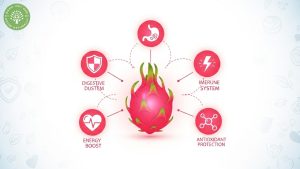
Understanding how red dragon fruit nutrients translate into real health benefits helps us appreciate why this fruit has gained superfood status. Each nutrient plays a specific role in supporting various bodily functions.
The high fiber content promotes digestive health by feeding beneficial gut bacteria and maintaining regular bowel movements. We’ve noticed many of our customers report improved digestion after incorporating red dragon fruit into their daily routine. The prebiotic properties of dragon fruit fiber specifically support the growth of lactobacilli and bifidobacteria – crucial for gut health.
Vitamin C and betalain antioxidants work synergistically to strengthen immune defenses. During cold and flu season, we recommend adding red dragon fruit to morning smoothies for an immune boost. The antioxidants neutralize free radicals that can damage cells and accelerate aging processes.
Magnesium and B vitamins in red dragon fruit support energy production at the cellular level. Unlike caffeine that provides temporary stimulation, these nutrients help your body produce sustainable energy throughout the day. The iron content aids oxygen transport to cells, preventing fatigue and supporting mental clarity.
Red vs white dragon fruit nutritional comparison
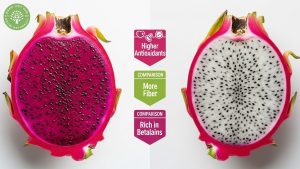
Many customers ask us about the nutritional differences between red and white dragon fruit varieties. While both offer excellent nutrition, there are some key distinctions worth noting.
Đây là đoạn văn đã điều chỉnh với mật độ từ khóa chính cao hơn:
Antioxidant content differences
Red dragon fruit nutrients include significantly higher levels of antioxidants compared to white varieties. The betalain content is exclusive to red varieties, providing anti-inflammatory benefits not found in white dragon fruit. Studies examining red dragon fruit nutrients suggest they may contain up to 10 times more antioxidants than white varieties.
Fiber and mineral variations
Interestingly, red dragon fruit nutrients typically include more fiber than white varieties – about 1-2 grams more per serving. The mineral content also differs, with red varieties generally providing more iron, phosphorus, and magnesium. White dragon fruit tends to be slightly higher in calcium and contains fewer natural sugars compared to the robust red dragon fruit nutrients profile.
Caloric and sugar content
Red dragon fruit contains marginally more calories due to its higher natural sugar content – about 10-15% more than white varieties. However, the glycemic index remains low for both types, making them suitable for blood sugar management. The additional sugars in red dragon fruit nutrients come with the benefit of enhanced antioxidant activity.
How to maximize nutritional benefits from red dragon fruit
At Ogani VN, we believe knowing how to properly select, store, and consume red dragon fruit ensures you get maximum red dragon fruit nutrients from every bite.
Selection and storage tips
Choose fruits that feel heavy for their size with bright, evenly colored skin to ensure optimal red dragon fruit nutrients. The scales should be fresh-looking without too many brown spots. Slight give when gently pressed indicates ripeness. We recommend storing ripe dragon fruit in the refrigerator for up to 5 days to preserve nutrients.
Unripe fruits can be left at room temperature until the skin develops a bright red color. Once cut, store in an airtight container and consume within 2 days to maintain the integrity of red dragon fruit nutrients. Freezing dragon fruit maintains most nutrients and creates a refreshing frozen treat.
Best consumption methods
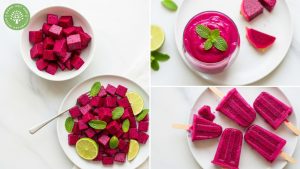
Eating red dragon fruit fresh provides the most red dragon fruit nutrients. Simply cut in half and scoop out the flesh with a spoon, or peel and cube for fruit salads. The seeds are edible and provide additional fiber and healthy omega-3 fatty acids.
Blending red dragon fruit into smoothies preserves all nutrients while making them more bioavailable. We love combining it with coconut water, banana, and a handful of spinach for a nutrient-packed breakfast. Adding a squeeze of lime enhances vitamin C absorption.
Pairing with other foods
Certain food combinations can enhance nutrient absorption from red dragon fruit. Pairing with vitamin C-rich citrus fruits boosts iron absorption. Adding healthy fats like nuts or avocado helps absorb fat-soluble vitamins. Combining with probiotic yogurt creates a synergistic effect for gut health.
Frequently asked questions
How many calories are in one whole red dragon fruit? A medium-sized red dragon fruit (about 200g) contains approximately 100-120 calories. This makes it a satisfying yet low-calorie snack option that provides substantial nutrition without excessive energy intake.
Can diabetics safely consume red dragon fruit? Yes, red dragon fruit has a low glycemic index despite its natural sweetness. The high fiber content helps slow sugar absorption, preventing blood sugar spikes. We recommend diabetics enjoy it in moderation as part of a balanced diet.
What’s the best time to eat red dragon fruit for maximum benefits? Morning consumption on an empty stomach maximizes nutrient absorption. The natural sugars provide energy for the day ahead while the fiber promotes healthy digestion. Post-workout is another excellent time as the nutrients aid recovery.
Are there any side effects from eating too much red dragon fruit? Excessive consumption may cause mild digestive upset due to high fiber content. Some people experience reddish urine or stool – this is harmless and caused by betalain pigments. We suggest starting with half a fruit daily and adjusting based on tolerance.
How does red dragon fruit compare nutritionally to other superfruits? Red dragon fruit holds its own against acclaimed superfruits. It contains more iron than acai, more fiber than blueberries, and unique betalain antioxidants not found in other fruits. The vitamin C content rivals that of kiwi fruit.
Transform your health with nature’s crimson treasure
The exceptional red dragon fruit nutrients profile makes this exotic fruit a valuable addition to any healthy diet. From powerful antioxidants to essential minerals and vitamins, every bite delivers concentrated nutrition that supports overall wellness.
At Ogani VN, we’re committed to bringing you the freshest, highest-quality red dragon fruit to maximize these nutritional benefits. Whether you’re looking to boost immunity, improve digestion, or simply enjoy a delicious and nutritious treat, red dragon fruit delivers on all fronts. Ready to experience the benefits yourself? Contact our team today to learn about our premium red dragon fruit selections and discover creative ways to incorporate this superfruit into your daily routine.
Read more:
- Baking With Dried Red Dragon Fruit: Breads, Muffins & Cookies
- Dried Red Dragon Fruit vs Fresh: Color, Nutrition & When to Use Each
- Dried Mango Nutrition Facts: Complete Guide To Calories, Benefits & Health Impac
- Best Dried Mango No Sugar Added: Premium Quality Guide
- Red Dragon Fruit Nutrients – Complete Nutritional Guide


